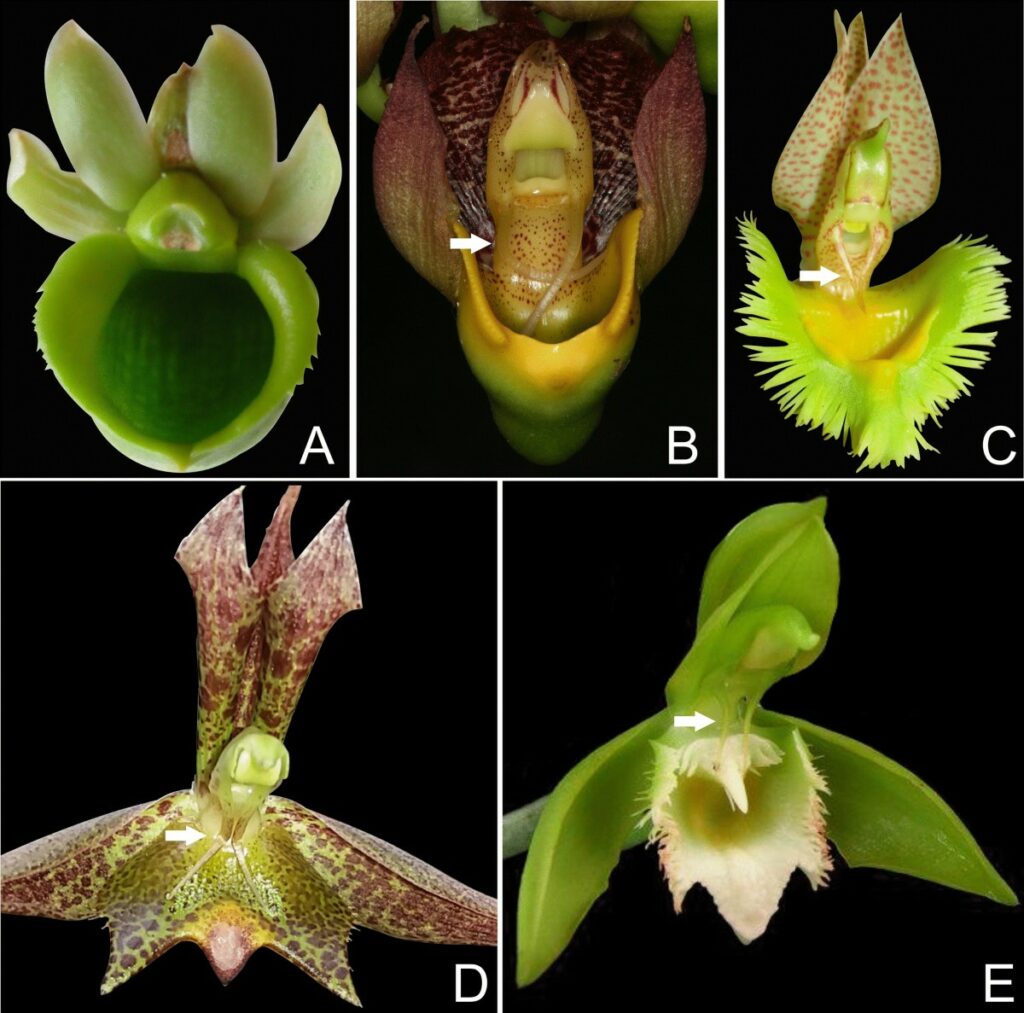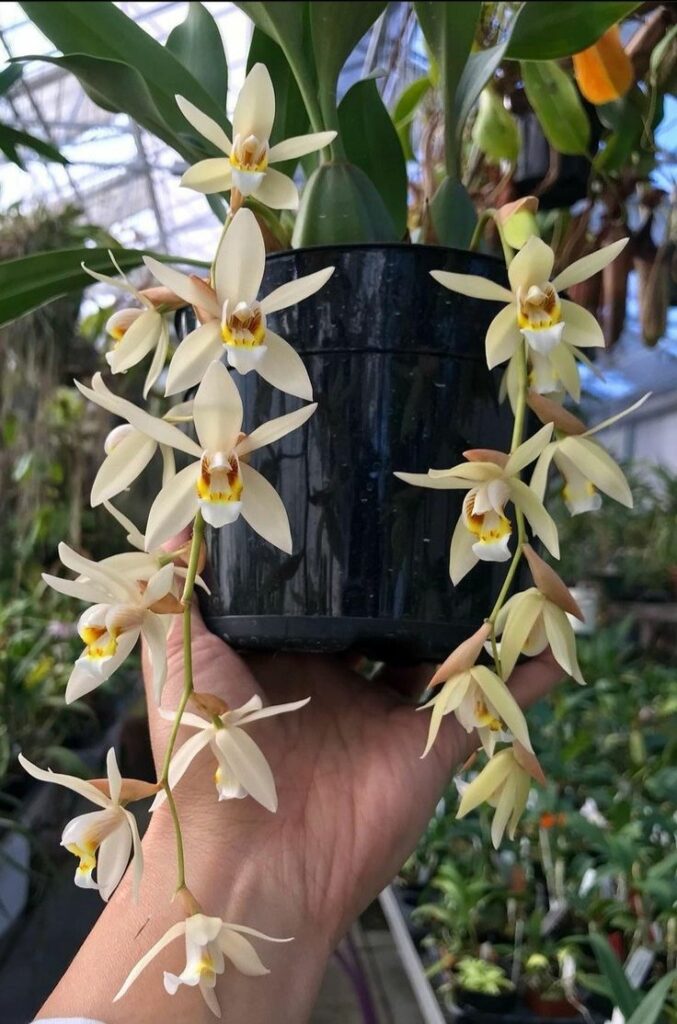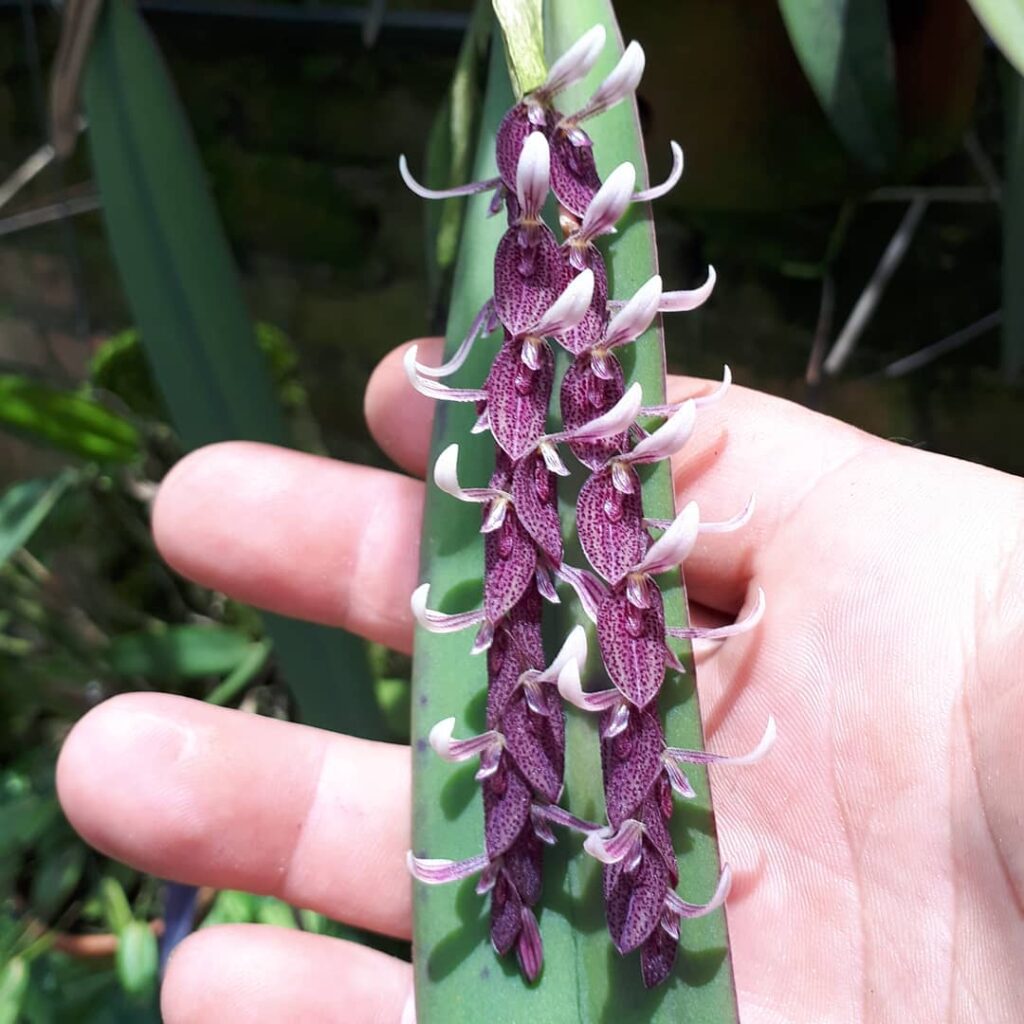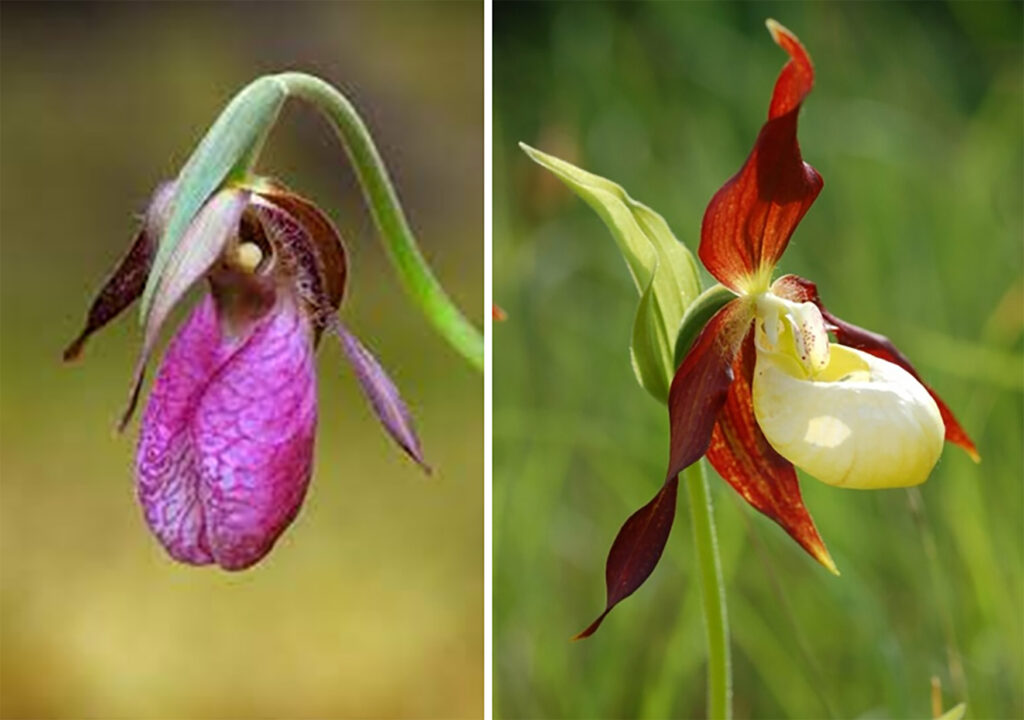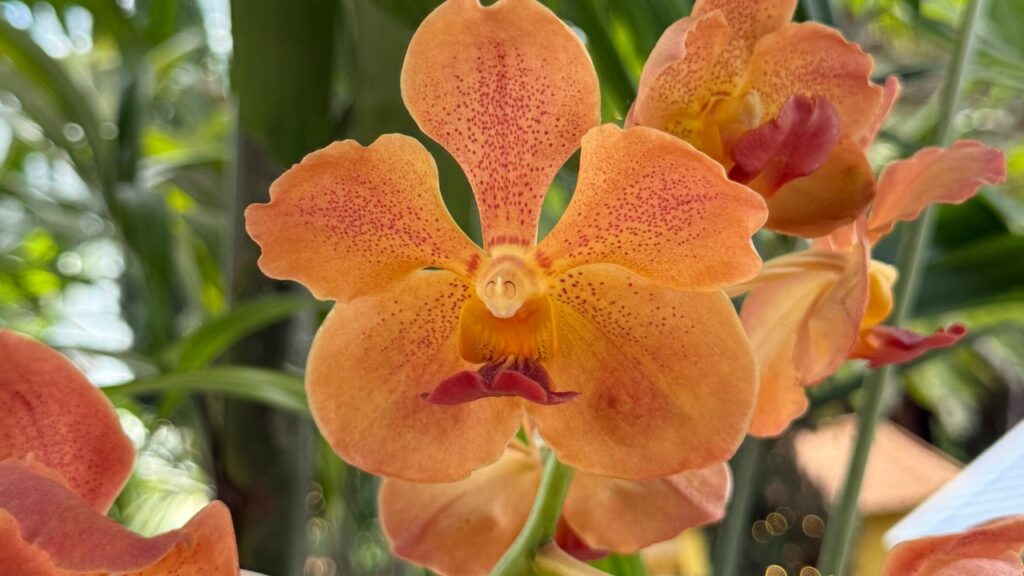No products in the cart.: ₹ 0.00
A story of Orchid alliances
Long ago, when botanists began untangling the great family tree of orchids, they -realized it wasn’t enough to simply name them one by one. There were too many – tens of thousands of species scattered across ever corner of the world. To bring order to this dazzling chaos, the American Orchid Society grouped them into sixteen great alliances – families within the family, each bound together by traits, histories and often by the journeys of explorers who first discovered them.
Imagine yourself stepping into a vast conservatory, where each wing opens to a different world. Let us begin our walk
- The Angraecum Alliance – The Orchids of Starlight
(Pronounced: an-GRAY-cum)
Here, night-blooming orchids shine like comets in the African sky. The Angraecum Alliance hails from Madagascar, Africa and the Indian Ocean islands, though a few wander as far as the Americas.
The star of this realm is Darwin’s Orchid, Anagraecum sesquipedale, with its impossibly long nectar spur. Darwin once predicted a moth must exist with a tongue long enough to reach it – and indeed, nature proved him right. Florida’s Ghost Orchid (Dendrophylax lindenii) also belongs here, haunting its swamps with flowers that appear to float like spirits.
- The Bulbophyllum Alliance – The Tricksters
(Pronounced: bulb-oh-FILL-um)
Step into a world of strangeness. With 2200 species, the Bulbophyllum Alliance is one of the largest, stretching from Africa to Asia, Madagascar to New Guinea.
These orchids are masters of trickery. Some release foul Odors to attract flies, others boast bizarre, hinged lips that wiggle like bait. Once divided into many genera – Cirrhopetalum, Trias and more – most are now united under Bulbophyllum. New Guinea alone shelters 600 species, making it the beating heart of their diversity.
- The Cattleya Alliance – The Orchids of Romance
(Pronounced: CAT-lee-ah)
Few orchids are as beloved as the Cattleyas. Once prized as corsage orchids, they remain symbols of elegance and passion. Their alliance spreads from the Caribbean down through South America, filling forests with flamboyant blooms.
Here live Cattleya, Epidendrum, and their many hybrids – hundreds upon hundreds bred by humans in search of the perfect flower. Some species even reach the coastal forests of North Carolina, while others thrive as far south as Uruguay. Whenever they bloom, they carry with them an air of grandeur.
- The Catasetum Alliance – The Bee’s Secret
(Pronounced: cat-a-SEE-tum)
This is an alliance of surprise. Here, orchids like Catasetum and Cycnoches bear male and female flowers so different that early botanists thought they were two separate plants.
When a bee lands on a male flower, the orchid snaps – literally firing a sticky pollen packet onto its body. The startled bee buzzes away, unknowingly carrying the orchid’s future. Seven genera belong here, all linked by their pollinators: the jewel-toned Euglossine Bees, who are enchanted by the orchids’ heady perfumes.- The Coelogyne Alliance – Orchids of the Mountains
(Pronounced: see-LODGE-eh-nee)
Now we travel east, into the misty mountains of Asia. The Coelogyne Alliance holds about 680 species, most thriving in the cool forests of the Himalayas, Southeast Asia, and the Pacific Islands.
The genus Coelogyne dominates here, with its graceful sprays of flowers in shades of white, gold and green. Many blooms in winter or early spring, offering their beauty when the world seems quietest. These orchids are beloved by collectors who treasure their delicate charm.- The Cymbidium Alliance – Orchids of the East
(Pronounced: sim-BID-ee-um)
Our path winds to Asia once more, where the Cymbidium Alliance reigns. With its 11 genera, this group stretches from the Himalayas to Japan, then South to New Guinea and Australia.
The Cymbidiums – or boat orchids – are among the most famous, their arching sprays of long- lasting flowers prized in floral arrangements. In China, they have been cultivated for centuries, admired not only for their beauty but for their symbolic meaning: elegance, friendship and integrity.
- The Dendrobium Alliance – The Great Wanderers
(Pronounced: den-DRO-bee-um)
Here stands one of the giants of the orchid world : the Dendrobium Alliance with about 1450 species. Once divided into many smaller genera, they are now united Dendrobium.
Their range is vast – from Sri Lanka across Asia and the Pacific, all the way to New Zealand. Some produce sprays of tiny blooms, other great, showy flowers. Collectors often find old plant tags still being names from the past, like Cadetia or Diplocaulobium, echoes of a time before modern science reunited them.- The Maxillaria Alliance – Orchids of the Rainforest
(Pronounced: max-ih-LARE-e-uh)
Now we enter the lush Neotropics. The Maxillaria Alliance counts around 720 species, thriving in South America’s Andes and Brazil’s Atlantic Rainforest.
Though once many genera, they are now largely gathered under Maxillaria. Their flowers are often small, but richly fragrant – some smell of coconut, others of vanilla or honey. In the dense, damp forests they inhabit, their scents are a guide for pollinators.
(Pronounced: max-ih-LARE-e-uh)
Now we enter the lush Neotropics. The Maxillaria Alliance counts around 720 species, thriving in South America’s Andes and Brazil’s Atlantic Rainforest.
Though once many genera, they are now largely gathered under Maxillaria. Their flowers are often small, but richly fragrant – some smell of coconut, others of vanilla or honey. In the dense, damp forests they inhabit, their scents are a guide for pollinators.
- The Oncidium Alliance – The Dancing Orchids
(Pronounced: on-SID-dee-um)
Imagine a sea of golden flowers, each one like a tiny dancer with outstretched skirts. This is the Oncidium Alliance, spread across the Americas with nearly 1600 species.
DNA studies have redrawn this family tree, gathering many former genera – Odontoglossum, Cochlioda and others – into Oncidium. The result is dazzling array, from the misty mountains of Peru to the sunlit forests of Florida. Beloved by hobbyists, their hybrids often carry the charm of dancing sprays that can bloom for months.
- The Phalaenopsis Alliance – The Moth Orchids
(Pronounced: fayl-eh-NOP-siss)
Here we meet the Phealaenopsis, the orchids most people know : elegant, long-lasting blooms that resemble butterflies or moth in flight.
Once divided into many genera – Doritis, kingidium and more – they are now united under Phalaenopsis. Though their taxonomy has shifted, their popularity never has. These are the orchids that fill garden centers and living rooms, the ambassadors of the orchid world.- The Pleurothallid Alliance – The Miniature Kingdom
Tiny orchids, countless in number, fill this alliance. With 4000 species across 38 genera, the Pleurothallids are centered in the Andean cloud forests.
Here we find Masdevallia, Dracula, Restrepia and Lepanthes – names that stir excitement among collectors of miniatures. Some bear flowers like jewelled insects, others like bat faces or fantastical masks. Their diversity is staggering, a reminder that orchids need not be large to be extraordinary- The Slipper Alliance – The Orchids with Shoes
These are the Lady’s Slippers, orchids whose lips form pouch-like shoes. Their distribution spans Eurasia, the Americans and Tropical Asia.
Here we meet five genera :
1. Cypripedium - the hardy slippers of Northern Forests.
2. Pophiopedilum - the jewel slippers of Asia
3. Phragmipedium - South America's treasures, some flaming scarlet
4. Mexipedium - a rare gem of Mexico.
5. Selenipedium - the moon slippers of South America.
Each slipper is a trap of elegance, guiding insects deep inside to ensure pollination.- The Stanhopea Alliance – The Perfumed Wonders
(Pronounced : stan-HOPE-ea)
Few orchids overwhelm the senses like those of the Stanhopea Alliance. With 270 species across 20 genera, they inhabit the tropics of the Americas.
Their flowers are often enormous, short-lived, but unforgettable – bursting with powerful, resinous scents that lure in their pollinators: the Euglossine Bees. To see a Stanhopea bloom is to witness an event, not just a flower.- The Vanda Alliance – The Jewel Orchids of Asia
(Pronounced: VAN-duh)
The Vanda Alliance is vast : about 1550 species across 80 genera, from India to Japan, Tahiti to New Zealand. Some even grow in Africa and Madagascar.
These orchids are radiant, with flowers in brilliant blues, purples and reds. Their hybrids are staples of tropical horticulture. Among them hides a gem: Neofinetiafalcata, once called the Samurai Orchid, treasured in Japan for centuries.
- The Zygopetalum Alliance – Orchids of Bold Color
(Pronounced: zy-go-PET-a-lum)
From Mexico to Argentina, the Zygopetalum Alliance thrives. About 35 genera dwell here, bearing flowers that are bold and fragrant – splashed with greens, purples and chocolates.
Zygopetalum maxillare carries its beauty South to Paraguay and Argentina, while Warrea warreana brightens forests with its striking blooms. These orchids are prized for their unique patterns and strong scents.
(Pronounced: zy-go-PET-a-lum)
From Mexico to Argentina, the Zygopetalum Alliance thrives. About 35 genera dwell here, bearing flowers that are bold and fragrant – splashed with greens, purples and chocolates.
Zygopetalum maxillare carries its beauty South to Paraguay and Argentina, while Warrea warreana brightens forests with its striking blooms. These orchids are prized for their unique patterns and strong scents.
- The Miscellaneous Alliance – The Outliers
Finally, we arrive at the catch-all : the Miscellaneous Alliance. Here are the orchids that don’t fit neatly into other groups – about 160 genera from around the globe.
This alliance includes the terrestrial orchids of Europe, the delicate ground orchids of Australia and the shimmering jewel orchids of the tropics, whose leaves gleam like velvet embroidered with gold.And so our journey ends -
Sixteen Alliances, each a world unto itself, bound together in the great, sprawling family or orchids. From ghostly apparitions in Florida swamps to jewel-like slippers in Asian Forests, orchids tell a story not just of flowers, but of the earth itself – diverse, resilient and endlessly enchanting.





